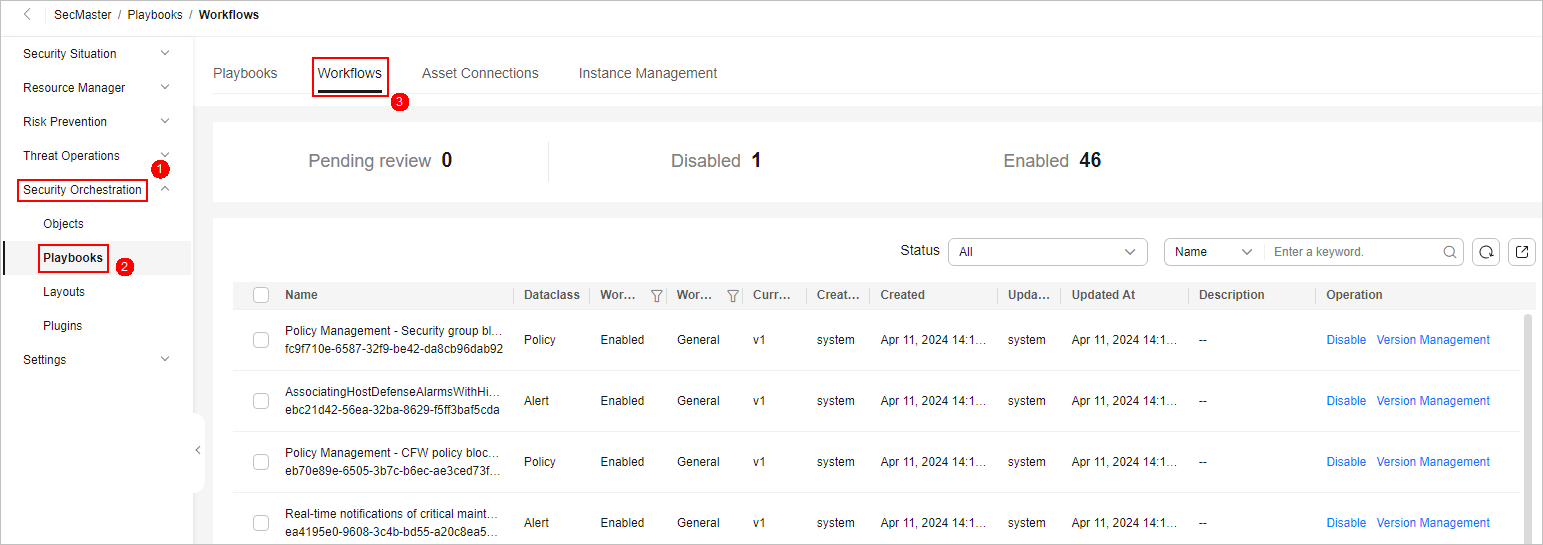(Optional) Configuring and Enabling a Workflow
Scenario
SecMaster provides some built-in workflows such as WAF uncapping, Synchronization of HSS alert status, and Fetching indicator from alert. Their initial version (V1) has been activated by default.
You can customize and edit existing workflows. This topic describes how to configure and enable custom workflows.
Enabling a Workflow of a Custom Version
Accessing the workflow management page
- Log in to the management console.
- Click
 in the upper left corner of the management console and select a region or project.
in the upper left corner of the management console and select a region or project. - Click
 in the upper left corner of the page and choose Security & Compliance > SecMaster.
in the upper left corner of the page and choose Security & Compliance > SecMaster. - In the navigation pane on the left, choose Workspaces > Management. In the workspace list, click the name of the target workspace.
Figure 1 Workspace management page

- In the navigation pane on the left, choose Security Orchestration > Playbooks. Click Workflows.
Figure 2 Workflows tab page

Copying a workflow version
- In the Operation column of the target workflow, click More and select Version Management.
Figure 3 Version Management page

- On the Version Management slide-out panel for the workflow, in the Version Information area, locate the row containing the target workflow version, and click Clone in the Operation column.
- In the displayed dialog box, click OK.
Editing and submitting a workflow version
- On the Version Management slide-out panel for the workflow, in the Version Information area, locate the row containing the target workflow version, and click Edit in the Operation column.
- On the workflow drawing page, drag basic, workflow, and plug-in nodes from Resource Libraries on the left to the canvas on the right for workflow design.
Table 1 Resource Libraries parameters Parameter
Description
Basic
Basic Node
StartEvent
The start of a workflow. Each workflow can have only one start node. The entire workflow starts from the start node.
EndEvent
The end of a workflow. Each workflow can have multiple end nodes, but the workflow must end with an end node.
UserTask
When the workflow execution reaches this node, the workflow is suspended and a to-do task is generated on the Task Center page.
After you complete the task, the subsequent nodes in the workflow continue to be executed.
Table 2 describes the UserTask parameters.
SubProcess
Another workflow is started to perform cyclic operations. It is equivalent to the loop body in the workflow.
System Gateway
ExclusiveGateway
During line distribution, one of the multiple lines is selected for execution based on the condition expression.
During line aggregation, if one of the multiple lines arrives, the subsequent nodes continue to execute the task.
ParallelGateway
During line distribution, all lines are executed.
During line aggregation, the subsequent nodes are executed only when all the lines arrive. (If one line fails, the entire workflow fails.)
InclusiveGateway
During line distribution, all expressions that meet the conditions are selected for execution based on the condition expression.
During line aggregation, subsequent nodes are executed only when all lines executed during traffic distribution reach the inclusive gateway. (If one line fails, the entire workflow fails.)
Workflows
You can select all released workflows in the current workspace.
Plug-ins
You can select all plug-ins in the current workspace.
Table 2 UserTask parameters Parameter
Description
Primary key ID
The system automatically generates a primary key ID, which can be changed as required.
Workspace Name
Name of the manual review node
Expired
Expiration time of a manual review node
Description
Description of the manual review node
View Parameters
Click
 . On the Select Context page that is displayed, select an existing parameter name. To add a parameter, click Add Parameter.
. On the Select Context page that is displayed, select an existing parameter name. To add a parameter, click Add Parameter.Manual Handling Parameters
Key of the input parameter To add a parameter, click Add Parameter.
Processed By
Set the reviewer of the workflow to the IAM user of the current IAM account. If a workflow needs to be approved after the setting, only the owner can handle it on the Task Center page. Non-owners can only view the workflow.
NOTE:In first time use, you need to obtain authorization. Detailed operations are as follows:
- Click Authorize.
- On the Access Authorization slide-out panel displayed, select Agree and click OK.
- After the design is complete, click Save and Submit in the upper right corner. In the automatic workflow verification dialog box displayed, click OK.
If the workflow verification fails, check the workflow based on the failure message.
Reviewing a workflow version
- After the workflow version is edited and submitted, the workflow management page is displayed. On the workflow management page, click Version Management in the Operation column of the target workflow.
Figure 4 Version Management page

- On the Version Management slide-out panel for the workflow, click Review in the Operation column of the target workflow.
- In the displayed dialog box, set Comment to Passed and click OK.
Activating a workflow version
- On the Version Management slide-out panel for the workflow, in the Version Information area, locate the row containing the target workflow version, and click Activate in the Operation column.
- In the displayed dialog box, click OK.
Enabling a workflow
Some workflows have been enabled by default. You can enable other ones based on your needs. The procedure is as follows:
- On the Version Management slide-out panel, click Enable in the Operation column of the target workflow.
- On the slide-out panel displayed, select the workflow version to be enabled and click OK.
Feedback
Was this page helpful?
Provide feedbackThank you very much for your feedback. We will continue working to improve the documentation.See the reply and handling status in My Cloud VOC.
For any further questions, feel free to contact us through the chatbot.
Chatbot





